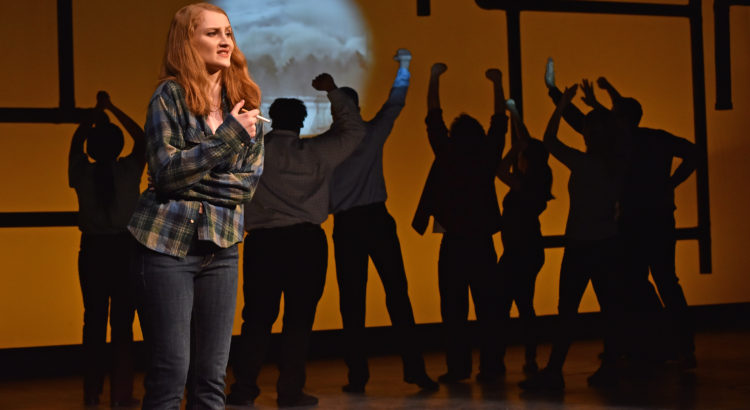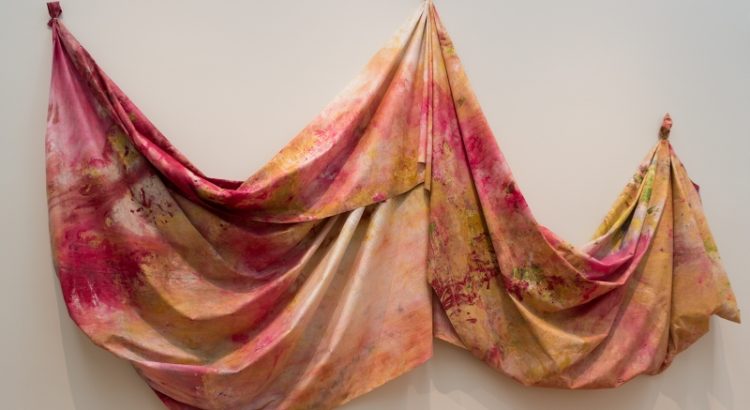The Dreams the Dreamers Dreamed is an exhibit in GalleryDAAS. GalleryDAAS is a gallery space in Mason Hall between the posting wall and SSD sponsored by the Department of African and Afro-American Studies. This gallery was established in 2010 with its first exhibit being a collection of paintings by artist and DAAS lecturer, Jon Onye Lockard. The space features two contemporary Black visual art exhibits per school year, one in each semester. GalleryDAAS is open 10am-4pm Monday through Friday. The current exhibit will be available through this Friday April 19th.
Author: audreymg
-49-copy-3-750x410.jpg)
PREVIEW: The Lute
Have you ever seen Chinese Opera? I certainly haven’t. Saturday’s performance of The Lute is the perfect chance to fix that! The Confucius Institute is hosting the Suzhou Kunqu Opera Theater for this unique opportunity in the Michigan Theater tomorrow for FREE to anyone who RSVPs. This opera is a classic Chinese story about a man named Cai Bojie who must juggle duty to his country, loyalty to his family, and love for two different women. The story was first written Gao Ming in the 1340s but has been constantly discussed and reworked in Chinese culture since its creation. The story traditionally acts as an allegory for Chinese loyalty, responsibility, sacrifice, and familial duty. However, the version which will presented at this performance was premiered in 2018 in Suzhou and offers commentary on life in China today.
I am excited to see how my concept of opera, based on the German and Italian operas I have listened to or seen, will be expanded by seeing a non-Western version of the artform. I expect to see differences between European and Chinese opera in both the performance aspects and the storyline. Instrumentation, singing, and dance styles will surely be different from those featured in pieces like the Marriage of Figaro. I expect that the storytelling aspect will differ as well. European opera follows the rigid lines of comedy and drama fairly well with the classic pyramid shaped plot. I’m curious to see how The Lute shapes its tale without those rigid expectations to follow, creating a different flow.
Image courtesy of the Confucius Institute.
PREVIEW: The Public
I will be reviewing the Public because it struck me as an interesting premise for a film. The movie tells the story of a group of homeless folks occupying a library during a bitter cold front. I can’t think of another movie that I’ve seen which focuses on the homeless population, let alone painting them as protagonists. In the US we have a large homeless population despite the fact that we also have enough homes to house them. Our society has put an emphasis on charity work for the homeless with soup kitchens and shelters, but hasn’t stressed the importance of knowing homeless folk as individuals and valuing them as part of our society. This movie seems like it is trying to move the issue surrounding homelessness into the light and question the way we perceive the community. I am hopeful that it does this goal justice. The Public just opened and will be playing at the Michigan Theater through April 17th so this week is your chance to go see it!

REVIEW: The Aftermath
It was a scandalous romance set in post war Germany with Keira Knightly and the couple that I was rooting for didn’t end up together, so it was exactly the movie that I expected. What I didn’t expect was to have the Michigan Theater main auditorium basically to myself when I watched it. It was my first time seeing a movie in the main auditorium (I saw Rocky Horror there but that was a performance so it doesn’t count) and I was pretty excited since that room is gorgeous, but the experience was a little disappointing. The only people in the room were the projector operator who kept wiping the projector lens during the commercials, my friend and I, and a couple halfway back in the theater. While I was originally excited at the concept of having the place to myself, it actually detracted from the experience. With such a large room and so few bodies to absorb the sound it was echoey and made things a bit difficult to understand occasionally.
As for the movie itself, I enjoyed just as much as an romantic drama set in another time period, but it wasn’t fantastic. My main complaint is that it felt abrupt and choppy. The romance between the main characters developed out of nowhere, hatred between the daughter and Keira Knightly’s character turned to friendship in a matter of seconds, an awkward sex scene turned into full-fledged love in the course of a couple days. It just felt like the story did not give these relationships enough time to develop. Also, I hated the ending. I love happy endings, I want everything to go exactly the way that they make you want them to go. Given this fact, its not surprising that I like romantic comedies, but it makes my relationship with dramas fraught. Keira Knightly and her husband have been apart for years during the war and they agree that the death of their son destroyed their relationship. It felt like they were agreeing that separation was for the best. Anyone from the outside could agree. And yet, she chooses to leave the man that is making her happier than she has been in years for the marriage she already decided was over. While I am not condoning cheating or affairs, sometimes people need to leave relationships that aren’t healthy anymore for new ones and that isn’t always an easy thing to navigate. It would be great if dramas could catch up with the times to display romantic relationships as the complex, unique phenomena that they are.
Image courtesy of rogerebert.com.

REVIEW: FLINT
Let me start off by saying that I am from Flint, Michigan. I was born and raised in the city and had lived there my entire life until I came to Ann Arbor. When the water crisis started I was in my junior year of high school and we knew something was wrong but had no idea of the magnitude and the problems to come. I still call Flint home and go there often to visit family and the community I love. First semester freshman year in college is hard enough as it is but my experience was made even more complicated when the water crisis broke international news. Suddenly it was my hometown in the news, spread across my facebook news feed, and as the subject of conversation everywhere. When people found out where I was from they would ask in horror how my family was, as if my city had survived the latest natural disaster. Many people, with both good and not so pure intentions, were focused on producing media around the issue and holding fundraisers. It often felt like my hometown was being sensationalized as a pitiable, suffering place. I have become incredibly cynical about outside activism centered around my city and our crisis due to these experiences; that is why I was very skeptical when I first learned about FLINT being produced on our campus.
In spite of my skepticism, FLINT blew me away. I am still processing the weight of the production. A couple scenes from the play really stuck with me as they resonated with my experiences or taught me something new. In the first half of the play one scene depicted a conversation of Umich students and faculty from Flint discussing their complicated relationships with the city. They spoke truths that I have been mulling over since I came to Ann Arbor, the fact that we identify as being from Flint, call it our home, but also acknowledge our privilege as members of the Umich community here. Another scene that stuck with me was the nurse character’s perspective as a health professional in this health crisis. While her impressions of the crisis itself were powerful, the part that really got to me was when she said exactly what I’ve been saying and feeling for years; things were bad before the water crisis, and no one cared about us then. Though the water crisis has shook my community, we were struggling long before it due to a government which does not care about poor, rustbelt, communities of color. We were abandoned long ago, making the water crisis almost inevitable. What I was not necessarily expecting was to learn about my city and its experience with this crisis. Flint is home to the Michigan School for the Deaf, but I was completely shocked by the scene detailing the experience of the daughter of deaf parents. I never thought about the role this sub-group plays in my community and the different ways it affected them.
Another unexpected experience that I had watching this play was nostalgia. I did not know any of the characters represented in this play, but they felt familiar. I recognized the traits that Flint instills in a person and the places which they occupied. Pictures taken in everyone’s favorite diner, Starlite; a prom scene set in Northwestern high school the spring before the school closed. I knew it was a play about my hometown when I could single out the places and experiences they described in the most vague of terms. I know better than anything not to go in the Flint River, I remember when they found a dead, frozen body in it one winter. The new, exciting bookstore opened downtown is called Totem Books and I’ve passed it in the car a million times, heard all the buzz surrounding it with little recognition for Black-owned bookstores in other parts of the city. I’m worried about the gentrification I’ve spent my life watching expand through the downtown area, just like that barber. This play didn’t include my narrative, but it was about me, my family, my community, and my hometown.
Picture courtesy of SMTD.

PREVIEW: Abstraction, Color, and Politics in the 1970s
The title for this exhibit is kind of like a word cloud for the words most associated with the 1970s. I think of the era of sex, drugs, and rock n roll, a time full of psychedelics and political protests. I’m curious to see how this exhibit takes those mental images and translates them into a collection of art. However, I think this exhibit may not quite be my favorite art exhibit. I have an appreciation for certain forms of contemporary art, but struggle with many of the early explorations in this art form from the 1960s and 1970s. The flagship piece of this exhibit seems to be a painted tarp artfully draped on the wall. A piece like this seems like it would create for a nice, calming space and good home decor, but I’m not so sure if I think it can represent political thought. I’ll be heading over to the UMMA to decide why I draw the lines in the age-old discussion of “what is art?”. Make sure to catch this exhibit this summer as it will be leaving at the end of September 2019!

